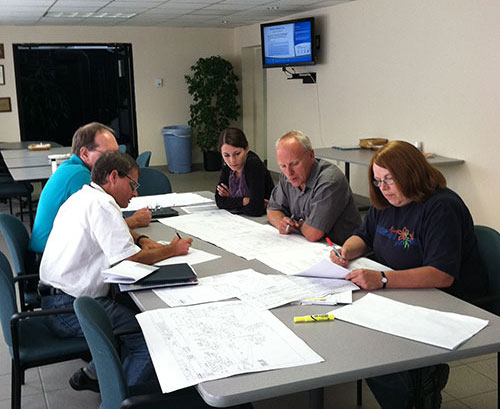
“It looked good on paper.” We’ve all heard that before, or thought it ourselves, haven’t we? This statement is even the case in our line of work in engineering and skilled trades services – what looks good on paper may not work out so well in practice.
Last week I met with Wayne, one of our sheet metal fabricators, to go over his certifications and experience for his Optimation resume – we put together resumes for all of our employees, so that clients can get to know their backgrounds and skillsets before they work with us on a project.
As we were going over his work experience, I noticed that often on projects, Wayne would offer his perspective on designs to our engineering and design team. He could tell by looking at a design if it would translate well into fabrication.
One example he gave was for a client in the food and beverage industry who made peanut butter. We had designed hoppers, to be fabricated in our shops and installed in the client’s facility. Since Wayne and the engineering and design team all worked for Optimation, he could easily be a part of the design review process. And on one review, he noted that the hopper designs would pose a potential issue for cleaning. He made a recommendation to facilitate easier cleaning and this was incorporated into the design.
Wayne’s expertise saved the client time and ease in cleaning the hoppers, and also from potentially having to do a rework later down the line. As he told the story, I thought, thank goodness he was sitting in on the design review, and was brought in as a trusted team member throughout the life of the project, not just the fabrication. Our other skilled tradesmen behave in the same way. Many of them have decades of experience in fabricating and applying designs, and they use that knowledge to improve a design before it’s made.
This may sound like it should be the case in every manufacturing facility or with every service provider, but while many may also have both engineering and fabrication capabilities together in-house, it may not always be so straightforward.
I used to work for a fabrication company while I was still in college. While working for the engineering department, one of my jobs was to go through the recommendations from people on the shop floor. When an order for a part would go through our shop, it would pass through different work centers: laser cutting, press brake, punch press, welding, etc. Each person working on the part in each work center could give their feedback on how the design translated to fabrication. Sometimes they made suggestions for improvements.
The problem was that these suggestions were batched in the engineering department. Depending on how busy engineering was, the suggestions would wait until things slowed down, and then the suggestions could be reviewed and evaluated. What ended up happening was that sometimes, parts ran through the shop a few times before the suggested improvements could be implemented.
This is the real benefit of not only having both engineering and skilled trades working together under one roof, but also working closely together on projects and design. Our team communicates openly, each person’s role on the project is respected and they are seen as the expert. This seamless team approach is what gives us a true advantage for our clients. It’s better to know up front that a design can be improved upon, rather than to find out after it’s been implemented in your plant.
